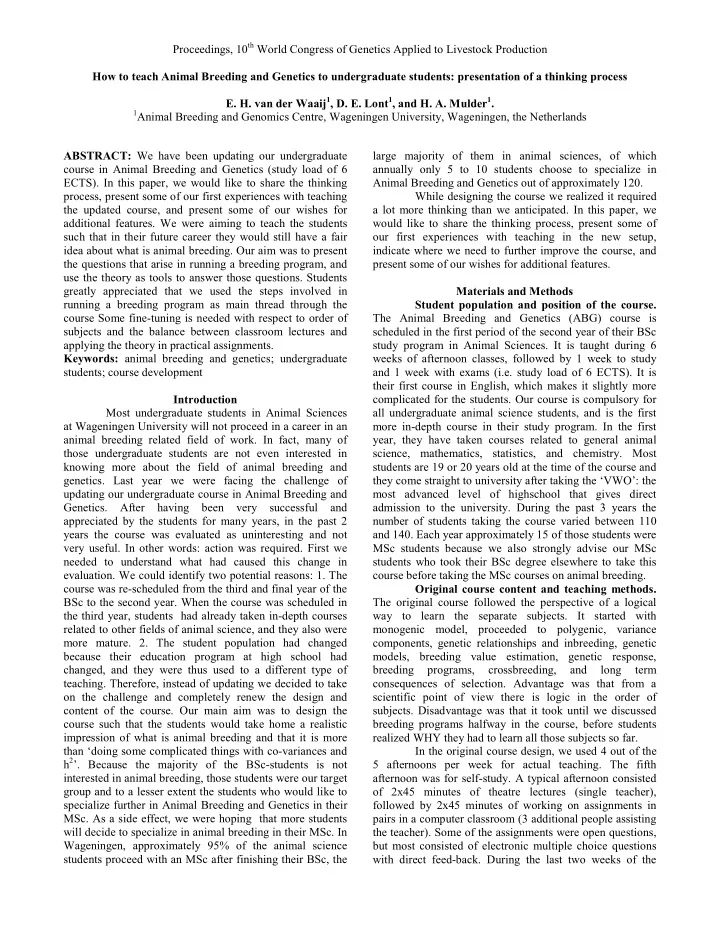

Proceedings, 10 th World Congress of Genetics Applied to Livestock Production How to teach Animal Breeding and Genetics to undergraduate students: presentation of a thinking process E. H. van der Waaij 1 , D. E. Lont 1 , and H. A. Mulder 1 . 1 Animal Breeding and Genomics Centre, Wageningen University, Wageningen, the Netherlands ABSTRACT: We have been updating our undergraduate large majority of them in animal sciences, of which course in Animal Breeding and Genetics (study load of 6 annually only 5 to 10 students choose to specialize in ECTS). In this paper, we would like to share the thinking Animal Breeding and Genetics out of approximately 120. process, present some of our first experiences with teaching While designing the course we realized it required the updated course, and present some of our wishes for a lot more thinking than we anticipated. In this paper, we additional features. We were aiming to teach the students would like to share the thinking process, present some of such that in their future career they would still have a fair our first experiences with teaching in the new setup, idea about what is animal breeding. Our aim was to present indicate where we need to further improve the course, and the questions that arise in running a breeding program, and present some of our wishes for additional features. use the theory as tools to answer those questions. Students greatly appreciated that we used the steps involved in Materials and Methods running a breeding program as main thread through the Student population and position of the course. course Some fine-tuning is needed with respect to order of The Animal Breeding and Genetics (ABG) course is subjects and the balance between classroom lectures and scheduled in the first period of the second year of their BSc applying the theory in practical assignments. study program in Animal Sciences. It is taught during 6 Keywords: animal breeding and genetics; undergraduate weeks of afternoon classes, followed by 1 week to study students; course development and 1 week with exams (i.e. study load of 6 ECTS). It is their first course in English, which makes it slightly more Introduction complicated for the students. Our course is compulsory for Most undergraduate students in Animal Sciences all undergraduate animal science students, and is the first at Wageningen University will not proceed in a career in an more in-depth course in their study program. In the first animal breeding related field of work. In fact, many of year, they have taken courses related to general animal those undergraduate students are not even interested in science, mathematics, statistics, and chemistry. Most knowing more about the field of animal breeding and students are 19 or 20 years old at the time of the course and genetics. Last year we were facing the challenge of they come straight to university after taking the ‘VWO’: the updating our undergraduate course in Animal Breeding and most advanced level of highschool that gives direct Genetics. After having been very successful and admission to the university. During the past 3 years the appreciated by the students for many years, in the past 2 number of students taking the course varied between 110 years the course was evaluated as uninteresting and not and 140. Each year approximately 15 of those students were very useful. In other words: action was required. First we MSc students because we also strongly advise our MSc needed to understand what had caused this change in students who took their BSc degree elsewhere to take this evaluation. We could identify two potential reasons: 1. The course before taking the MSc courses on animal breeding. course was re-scheduled from the third and final year of the Original course content and teaching methods. BSc to the second year. When the course was scheduled in The original course followed the perspective of a logical the third year, students had already taken in-depth courses way to learn the separate subjects. It started with related to other fields of animal science, and they also were monogenic model, proceeded to polygenic, variance more mature. 2. The student population had changed components, genetic relationships and inbreeding, genetic because their education program at high school had models, breeding value estimation, genetic response, changed, and they were thus used to a different type of breeding programs, crossbreeding, and long term teaching. Therefore, instead of updating we decided to take consequences of selection. Advantage was that from a on the challenge and completely renew the design and scientific point of view there is logic in the order of content of the course. Our main aim was to design the subjects. Disadvantage was that it took until we discussed course such that the students would take home a realistic breeding programs halfway in the course, before students impression of what is animal breeding and that it is more realized WHY they had to learn all those subjects so far. than ‘doing some complicated things with co-variances and In the original course design, we used 4 out of the h 2 ’. Because the majority of the BSc-students is not 5 afternoons per week for actual teaching. The fifth interested in animal breeding, those students were our target afternoon was for self-study. A typical afternoon consisted group and to a lesser extent the students who would like to of 2x45 minutes of theatre lectures (single teacher), specialize further in Animal Breeding and Genetics in their followed by 2x45 minutes of working on assignments in MSc. As a side effect, we were hoping that more students pairs in a computer classroom (3 additional people assisting will decide to specialize in animal breeding in their MSc. In the teacher). Some of the assignments were open questions, Wageningen, approximately 95% of the animal science but most consisted of electronic multiple choice questions students proceed with an MSc after finishing their BSc, the with direct feed-back. During the last two weeks of the
Recommend
More recommend